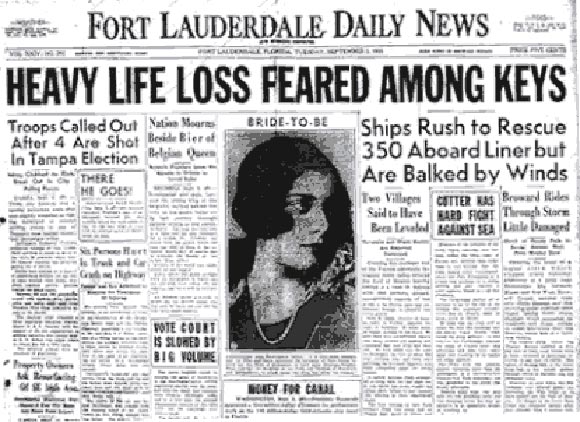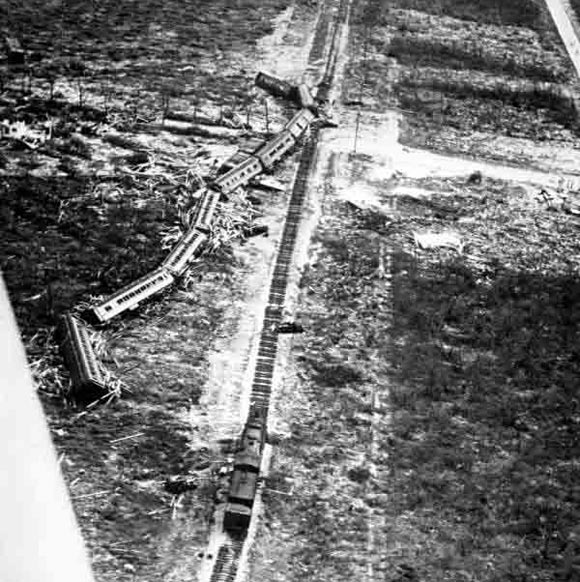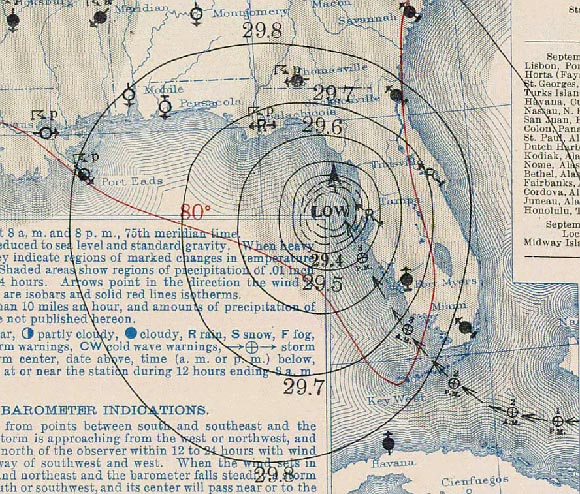Lowest sea level pressure ever officially recorded on land, suggesting an intensity of 189 mph

Known as the ‘Great Hurricane of 1935,’ Category 5 Storm killed an Estimated 400 to 600 People
The 1935 Labor Day hurricane (formally known as Hurricane Three) was the most intense Atlantic hurricane to make landfall on record in terms of both pressure and wind speed.
This hurricane was the most intense tropical cyclone known to make landfall in the Western Hemisphere, having the lowest sea level pressure ever officially recorded on land—a central pressure of 892 millibars (26.3 inHg)—suggesting an intensity of between 186 and 189 mph.
It was also the most intense Atlantic hurricane on record until Hurricane Gilbert in 1988.
The fourth tropical cyclone, third tropical storm, second hurricane, and second major hurricane of the 1935 Atlantic hurricane season, the Labor Day Hurricane was the first known Category 5 hurricane on record to strike the contiguous United States and which slammed into the Florida Keys.
Known as the “Great Hurricane of 1935,” the storm killed an estimated 400 to 600 people.
Many of the victims were World War I veterans working in a Depression-era program to build the highway connecting the Florida Keys — a fact that infuriated Ernest Hemingway, who lived in Key West at the time and wrote a scathing article titled “Who murdered the vets?”
The hurricane intensified rapidly, passing near Long Key on the evening of September 2. The region was swept by a massive storm surge as the eye passed over the area.
The waters quickly receded after carving new channels connecting the bay with the ocean; however, gale-force winds and high seas persisted into Tuesday, preventing rescue efforts.
The storm continued northwestward along the Florida west coast, weakening before its second landfall near Cedar Key, Florida, on September 4.

The compact and intense hurricane caused catastrophic damage in the upper Florida Keys, as a storm surge of approximately 18 to 20 feet swept over the low-lying islands.
The hurricane’s strong winds and the surge destroyed nearly all the structures between Tavernier and Marathon.
The town of Islamorada was obliterated. Portions of the Key West Extension of the Florida East Coast Railway were severely damaged or destroyed. The hurricane also caused additional damage in northwest Florida, Georgia, and the Carolinas.
On Upper Matecumbe Key, near Islamorada, an 11-car evacuation train encountered a powerful storm surge topped by cresting waves. Eleven cars were swept from the tracks, leaving only the locomotive and tender upright and still on the rails.
Remarkably, everyone on the train survived. The locomotive and tender were both barged back to Miami several months later.
Three veterans’ work camps existed in the Florida Keys before the hurricane and the camp payrolls for August 30 listed 695 veterans.
They were employed in a project to complete the Overseas Highway connecting the mainland with Key West.
An interesting footnote to this storm is that the first recorded instance of an aircraft flown for the specific purpose of locating a hurricane occurred on the afternoon of September 2, 1935. Captain Leonard Povey of the Aviation Corps of the Cuban Army volunteered to investigate the threat to the capital.
Flying a Curtis Hawk II, Captain Povey, an American expatriate, who was the Aviation Corps’ chief training officer, observed the storm north of its reported position. Because he was flying an open-cockpit biplane, he opted not to fly into the storm and later proposed an aerial hurricane patrol.
Nothing further came of this idea until June 1943, when Colonel Joe Duckworth and Lieutenant Ralph O’Hair flew into a hurricane near Galveston, Texas.
– Wikipedia



CLICK HERE FOR BREVARD COUNTY NEWS
The post 1935 Labor Day Hurricane That Hit Florida Keys Was First Known Category 5 On Record to Strike the Contiguous U.S. appeared first on Space Coast Daily.

